Assalamu'alaikum,
Hari-hari terakhir di Istanbul hamba penuhi dengan melawat Aya Sophia dan Muzium Topkapi. Memandangkan keduanya terletak bersebelahan, maka hamba ke Aya Sophia dahulu memandangkan hamba rasa hamba nak habiskan banyak masa di Istana/Muzium Topkapi. Aya Sophia memang lebih popular dalam kalangan orang Barat (Kristian) kerana 'sejarah gereja bertukar menjadi masjid'. Dari itu, dalam kalangan pelancong dari Barat, mereka menghabiskan banyak masa di Aya Sophia. Apatah lagi lukisan-lukisan lama tentang "Mary, Jesus" dan lain-lain watak masih ada terletak di dinding dan bumbung Aya Sophia. Seperti yang kita maklum, agama Kristian amat 'mendewakan' patung, lukisan, gambar, bentuk yang berkaitan dengan "Mary, Jesus dan Salib". "Jesus" adalah Tuhan bagi Kristian, Salib juga dipercayai sebagai satu simbol yang amat kuat dengan Tuhan mereka. Bagi orang Islam yang berfahaman Ahli Sunnah Wal Jamaah, Allah itu sepertimana dinyatakan dalam surah Al-Ikhlas, Ahad, yakni Esa (bukan satu kerana satu ada dua, tiga dan lain2), Tempat Bergantung segala sesuatu, tidak beranak dan tidak memperanakkan, dan tidak menyerupai sesuatu, tidak dapat dibandingkan DIA dengan yang lainnya, tidak setara DIA dengan kejadian-NYA, tidak dapat dikiaskan DIA dengan segala yang ada di muka bumi, mahupun di seluruh alam.
Tauhid merupakan perkara pokok dalam Islam. Dalam hal ini, para ulamak menyebut bagaimana 10 tahun pertama Islam di Mekah digunakan oleh RSAW menanam aqidah/tauhid yang betul dalam kalangan sahabat dan umat Islam. Apabila aqidahnya kukuh, imannya mantap, maka mudah menerima syariat Islam yang turun sedikit demi sedikit. Jika dilihat umat Islam sekarang, Islamnya sudah ada, tetapi aqidahnya 'ada yang bermasalah', apatah lagi dengan golongan Wahhabi yang menafsirkan ayat-ayat mutasyabihat mengikut faham mereka yang akhirnya merosakkan aqidah umat Islam. Ulamak-ulamak sekarang sibuk mencari kelemahan ulamak-ulamak terdahulu dalam kitab-kitab yang ditulis. Malang sekali apabila 'kelemahan' yang diketengahkan sedangkan kekuatan dan kehebatan itu diselindung. Hamba memang bukan arif bab hadis sebagai contoh. Tetapi kalau anda tanyakan ulamak sekarang, berapa ribu, puluh ribu atau ratusan ribu hadis "yang hilang" apabila Baghdad jatuh pada tahun 1258. Berapa banyak kitab tulisan ulamak dulu yang hilang apabila Baghdad jatuh? Malang sekali ulamak sekarang 'rasa hebat' dengan ilmu hadis yang sedikit dan mencari-cari kesalahan ulamak dulu dengan kaca mata mereka dan ilmu mereka yang sempit.
Hamba agak risau dengan golongan ustaz, ustazah, dan ulamak sekarang. Memang tidak salah mencari sedikit dunia untuk hidup, tetapi sebahagian ustaz, ustazah, dan ulamak sekarang diketahui mengenakan bayaran 'yang boleh tahan' untuk menyampaikan ilmu. Itukah peranan dan sumbangan ulamak? Itu belum dilihat kesepaduan ilmu mereka. Berapa ramai ulamak sekarang yang berceramah di sana-sini juga arif dalam perubatan Islam, kebatinan Islam, kerohanian selain menjadi seorang yang tawadhuk? Keilmuan kita di Universiti semakin menurut 'kacamata Yahudi dan sekular' kerana ulamak/profesor hanya tahu bidangnya sahaja tetapi tidak bersepadu fiqh, usuludin dan tasawuf di dalam dirinya. Ini belum dilihat mereka yang dikatakan ulamak (pensyarah universiti) dalam pengajian Islam tetapi akhlaknya ....
Bagi pengamal tasawuf, kita digemparkan dengan Tafsir al-Jailani yang 'disimpan' oleh Gereja Vatican dengan begitu lama (kira-kira 800 tahun) dan kini mula diterjemahkan dalam Bahasa Melayu dengan tulisan Rumi. Mengapa kitab ini 'boleh hilang' sebegitu lama dan 'disimpan' di Vatican? Bagi golongan 'underground', Vatican memang diketahui menyimpan pelbagai khazanah lama sama ada manuskrip, buku, tulisan dan sebagainya untuk tujuan mereka sendiri. Setakat itu dahulu celoteh hamba, posting seterusnya adalah berkaitan dengan Istana/Muzium Topkapi. Wassalam.
Deklarasi Masjid dijadikan Muzium
Gambar2 macam ini, dari pengaruh Kristian. Pemerintahan Islam selama dari 1453 tidak menghapuskan sepenuhnya gambar2 sebegini
Keunikan kaligrafi Islam di sebelah gambar ??
Seramik lama yang dijaga
Orang Kristian suka gambar2 macam ni
Senibina Khatib baca khutbah agak piawai di masjid2 di Istanbul
Mihrab yang ditinggalkan dan tidak digunakan semenjak 1931
Allah, Muhammad, Abu Bakar, Omar, Usman, Ali, Hassan dan Hussain ada di dalam Aya Sophia
Sedang dibaikpulih
Saki-baki Khat Islam di dinding
Biasanya ini tempat Sultan bersolat
Orang yang percaya 'tentang nasib' akan letakkan tapak tangan mereka di sini...
Hamba naik ke tingkat atas
Lantainya memang lantai lama dari dulu
Kembali 600 tahun ke zaman silam
Dah ada di tingkat atas
Di tingkat atas banyak lukisan/gambar tinggalan zaman Gereja
Gambar dari tingkat atas
Ajaran Kristian banyak unsur kerohanian, syariatnya tidak lengkap. Yang lengkap dan sempurna hanyalah Islam.
Sebab itu Nabi Isa A.S. akan 'turun semula' untuk menyedarkan orang Kristian tentang kesalahan dan kesilapan mereka serta mengakui dan mengikuti Islam yang dibawa Muhammad SAW yang merupakan agama terakhir (The Last Testament)
Kawasan lama untuk berwudhuk
Hamba dah keluar dari Aya Sophia
Lagi tempat berwudhuk
sumber : http://ms.wikipedia.org/wiki/Aya_Sophia
Hagia Sophia (B. Greek: Ἁγία Σοφία)Hagia Sophia (bahasa Turki: Ayasofya, bahasa Arab; آيا صوفيا , dari kata Yunani: Ἁγία Σοφία, "Holy Wisdom"; bahasa Latin: Sancta Sophia atau Sancta Sapientia) merupakan satu bangunan muzium di kota Istanbul. Bangunan ini sering dianggap sebagai bangunan yang teragung dan tercantik di dunia. Hagia Sofia dibina sebagai Gereja Besar Kristian Ortodoks tetapi diubahsuai menjadi masjid agung oleh kerajaan Turki Uthmaniyyah pada tahun 1453. Kerajaan Republik Turki telah menjadikannya sebagai muzium pada tahun 1935.
Dari gereja ke masjid ke muzium[sunting | sunting sumber]
Hagia Sophia asalnya dibina sebagai gereja antara tahun 532 dan 537 AD atas arahan Maharaja Byzantine Justinian. Ia direka oleh dua orang arkitek, Isidore dari Miletus dan Anthemius dari Tralles. Hagia Sophia menjadi gereja besar di Constantinople selama hampir 1000 tahun.
Pada tahun 1453, Constantinople ditawan oleh orang Turki Uthmaniyyah dan Sultan Muhammad al-Fatih mengarahkan bangunan itu diubahsuai menjadi masjid. Loceng, altar dan lain-lain berkenaan Kristian dibuang sementara lakaran di dinding ditampal. Ini semua diganti dengan unsur-unsur Islam seperti mihrab, mimbar dan empat menara di luar ditambah. Hagia Sophia kekal sebagai masjid sehingga tahun 1935 apabila ia ditukar kepada muzium oleh kerajaan Republik Turki.
Selama hampir 500 tahun, Hagia Sophia menjadi masjid utama di Istanbul dan model kepada masjid-masjid lain seperti Masjid Sultan Ahmed (Masjid Biru di Istanbul), Masjid Sehzade, Masjid Suleymaniye dan Masjid Rustem Pasha.
Gambaran[sunting | sunting sumber]
Hagia Sophia mempunyai satu kubah besar di tengah (diameter 31.87 m dan tinggi 55.60 m dari lantai) yang terletak di atas singgah kubah yang disokong oleh empat tiang sambut.
Dinding dalam ditutupi dengan batu marmar, mozek emas dan lain-lain. Di bahagian luar, dinding stuko ringkas menyerlahkan lagi kekubah dan kubah utam
sumber : http://en.wikipedia.org/wiki/Hagia_Sophia
"Aghia Sophia" redirects here. For the steamship, see SS Aghia Sophia. For other uses, see Hagia Sophia (disambiguation).
| Hagia Sophia Ayasofya (Turkish) Ἁγία Σοφία (Greek) Sancta Sophia (Latin) | |
|---|---|
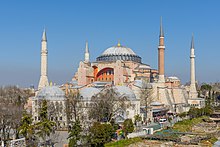
A view of Hagia Sophia, Istanbul
| |
| Coordinates | 41.008548°N 28.979938° |
| Location | Istanbul (historicallyConstantinople) Turkey |
| Designer | Isidore of Miletus Anthemius of Tralles |
| Type |
|
| Material | Ashlar, brick |
| Length | 82 m (269 ft) |
| Width | 73 m (240 ft) |
| Height | 55 m (180 ft) |
| Beginning date | 532 |
| Completion date | 537 |
Hagia Sophia (from the Greek: Ἁγία Σοφία, "Holy Wisdom"; Latin: Sancta Sophia or Sancta Sapientia; Turkish: Ayasofya) is a former Greek Orthodox patriarchal basilica (church), later an imperial mosque, and now a museum (Ayasofya Müzesi) in Istanbul, Turkey. From the date of its construction in 537 until 1453, it served as an Eastern Orthodox cathedral and seat of the Patriarchate of Constantinople,[1] except between 1204 and 1261, when it was converted to a Roman Catholic cathedral under the Latin Empire. The building was a mosque from 29 May 1453 until 1931. It was then secularized and opened as a museum on 1 February 1935.[2]
The Church was dedicated to the Wisdom of God, the Logos, the second person of the Holy Trinity,[3] its patronal feast taking place on 25 December, the commemoration of the Birth of the incarnation of the Logos in Christ.[3]Although sometimes referred to as Sancta Sophia (as though it were named after Saint Sophia), sophia being the phonetic spelling in Latin of the Greek word for wisdom, its full name in Greek is Ναός τῆς Ἁγίας τοῦ Θεοῦ Σοφίας, "Shrine of the Holy Wisdom of God".[4][5] Famous in particular for its massive dome, it is considered the epitome of Byzantine architecture[6] and is said to have "changed the history of architecture."[7] It remained the world's largest cathedral for nearly a thousand years, until Seville Cathedral was completed in 1520. The current building was originally constructed as a church between 532 and 537 on the orders of the Byzantine EmperorJustinian and was the third Church of the Holy Wisdom to occupy the site, the previous two having both been destroyed by rioters. It was designed by the Greek scientists Isidore of Miletus, a physicist, and Anthemius of Tralles, a mathematician.[8]
The church contained a large collection of holy relics and featured, among other things, a 15-metre (49 ft) silver iconostasis. The focal point of the Eastern Orthodox Church for nearly one thousand years, the building witnessed the excommunication of Patriarch Michael I Cerularius on the part of Pope Leo IX in 1054, an act which is commonly considered the start of the Great Schism.
In 1453, Constantinople was conquered by the Ottoman Turks under Sultan Mehmed II, who ordered this main church of the Orthodox Christianity converted into a mosque. By this point, the Church had fallen into a state of disrepair. Nevertheless, the Christian cathedral made a strong impression on the new Ottoman rulers and they decided to convert it into a mosque.[9][10] The bells, altar, iconostasis, and sacrificial vessels and other relics were removed and the mosaics depicting Jesus, his Mother Mary, Christian saints and angels were also removed or plastered over. Islamic features – such as the mihrab, minbar, and four minarets – were added. It remained a mosque until 1931 when it was closed to the public for four years. It was re-opened in 1935 as a museum by the Republic of Turkey.
From its initial conversion until the construction of the nearby larger Sultan Ahmed Mosque (Blue Mosque of Istanbul) in 1616, it was the principal mosque of Istanbul. The Hagia Sophia served as inspiration for many other Ottoman mosques, such as the Blue Mosque, the Şehzade Mosque, the Süleymaniye Mosque, the Rüstem Pasha Mosque and the Kılıç Ali Paşa Mosque.
Contents
[hide]History[edit]
First church[edit]
The first church on the site was known as the Μεγάλη Ἐκκλησία (Megálē Ekklēsíā, "Great Church"), or in Latin "Magna Ecclesia",[11][12] because of its larger dimensions in comparison to the contemporary churches in the City.[3]Inaugurated on 15 February 360 (during the reign of Constantius II) by the Arian bishop Eudoxius of Antioch,[13] it was built next to the area where the imperial palace was being developed. The nearby Hagia Eirene ("Holy Peace") church was completed earlier and served as cathedral until the Great Church was completed. Both churches acted together as the principal churches of the Byzantine Empire.
Writing in 440, Socrates of Constantinople claimed that the church was built by Constantius II, who was working on it in 346.[13] A tradition which is not older than the 7th – 8th century, reports that the edifice was built by Constantine the Great.[13] Zonaras reconciles the two opinions, writing that Constantius had repaired the edifice consecrated by Eusebius of Nicomedia, after it had collapsed.[13] Since Eusebius was bishop of Constantinople from 339 to 341, and Constantine died in 337, it seems possible that the first church was erected by the latter.[13] The edifice was built as a traditional Latin colonnaded basilica with galleries and a wooden roof. It was preceded by an atrium. It was claimed to be one of the world's most outstanding monuments at the time.
The Patriarch of Constantinople John Chrysostom came into a conflict with Empress Aelia Eudoxia, wife of the emperor Arcadius, and was sent into exile on 20 June 404. During the subsequent riots, this first church was largely burned down.[13] Nothing remains of the first church today.
Second church[edit]
A second church was ordered by Theodosius II, who inaugurated it on 10 October 415. The basilica with a wooden roof was built by architect Rufinus. A fire started during the tumult of the Nika Revolt and burned the second Hagia Sophia to the ground on 13–14 January 532.
Several marble blocks from the second church survive to the present; among them are reliefs depicting 12 lambs representing the 12 apostles. Originally part of a monumental front entrance, they now reside in an excavation pit adjacent to the museum's entrance after they were discovered in 1935 beneath the western courtyard by A. M. Schneider. Further digging was forsaken for fear of impinging on the integrity of the building.
Third church (current structure)[edit]
On 23 February 532, only a few weeks after the destruction of the second basilica, Emperor Justinian I decided to build a third and entirely different basilica, larger and more majestic than its predecessors.
Justinian chose physicist Isidore of Miletus and mathematician Anthemius of Tralles as architects; Anthemius, however, died within the first year of the endeavor. The construction is described in the Byzantine historian Procopius' On Buildings (Peri ktismatōn, Latin: De aedificiis). The emperor had material brought from all over the empire – such as Hellenistic columns from the Temple of Artemis at Ephesus, large stones from quarries in porphyry from Egypt, green marble from Thessaly, black stone from the Bosporus region, and yellow stone from Syria. More than ten thousand people were employed. This new church was contemporaneously recognized as a major work of architecture. The theories of Heron of Alexandria may have been utilized to address the challenges presented by building such an expansive dome over so large a space.[citation needed] The emperor, together with the Patriarch Menas, inaugurated the new basilica on 27 December 537 – 5 years and 10 months after construction start - with much pomp.[14][15][16] The mosaics inside the church were, however, only completed under the reign of Emperor Justin II (565–578).
Hagia Sophia was the seat of the Orthodox patriarch of Constantinople and a principal setting for Byzantine imperial ceremonies, such as coronations. Like other churches throughout Christendom, the basilica offered sanctuary from persecution to outlaws.
Earthquakes in August 553 and on 14 December 557 caused cracks in the main dome and eastern half-dome. The main dome collapsed completely during a subsequent earthquake on 7 May 558,[17] destroying the ambon, altar, and ciborium. The crash was due mainly to the too high bearing load and to the enormous shearing load of the dome, which was too flat.[14] These caused the deformation of the piers which sustained the dome.[14] The emperor ordered an immediate restoration. He entrusted it to Isidorus the Younger, nephew of Isidore of Miletus, who used lighter materials and elevated the dome by "30 feet"[14] (about 6.25 meters (20.5 ft)) – giving the building its current interior height of 55.6 meters (182 ft).[18] Moreover, Isidorus changed the dome type, erecting a ribbed dome with pendentives, whose diameter lay between 32.7 and 33.5 m.[14] Under Justinian's orders, eight Corinthian columnswere disassembled from Baalbek, Lebanon, and shipped to Constantinople around 560.[19] This reconstruction, giving the church its present 6th-century form, was completed in 562. The Byzantine poet Paul the Silentiarycomposed a long epic poem (still extant), known as Ekphrasis, for the rededication of the basilica presided over by Patriarch Eutychius on 23 December 562.
In 726, the emperor Leo the Isaurian issued a series of edicts against the veneration of images, ordering the army to destroy all icons – ushering in the period of Byzantine iconoclasm. At that time, all religious pictures and statues were removed from the Hagia Sophia. After a brief reprieve under Empress Irene (797–802), the iconoclasts made a comeback. Emperor Theophilus (829–842) was strongly influenced by Islamic art,[20] which forbids the representation of living beings.[21] He had a two-winged bronze door with his monograms installed at the southern entrance of the church.
The basilica suffered damage, first in a great fire in 859, and again in an earthquake on 8 January 869, that made a half-dome collapse. Emperor Basil I ordered the church repaired.
After the great earthquake of 25 October 989, which collapsed the Western dome arch, the Byzantine emperor Basil II asked for the Armenian architect Trdat (Armenian: Տրդատ ճարտարապետ; Latin: Tiridates), creator of the great churches of Ani and Argina, to direct the repairs.[22] He erected again and reinforced the fallen dome arch, and rebuilt the west side of the dome with 15 dome ribs.[23] The extent of the damage required six years of repair and reconstruction; the church was re-opened on 13 May 994. At the end of the reconstruction, the church's decorations were renovated, including the additions of paintings of four immense cherubs, a new depiction of Christ on the dome, and on the apse a new depiction of the Virgin Mary holding Jesus between the apostles Peter and Paul.[24] On the great side arches were painted the prophets and the teachers of the church.[24]
In his book De caerimoniis aulae Byzantinae ("Book of Ceremonies"), Emperor Constantine VII (913–919) wrote a detailed account of the ceremonies held in the Hagia Sophia by the emperor and the patriarch.
Upon the capture of Constantinople during the Fourth Crusade, the church was ransacked and desecrated by the Latin Christians. The Byzantine historian Niketas Choniates described the capture of Constantinople; many reputed relics from the church – such as a stone from the tomb of Jesus, the Virgin Mary's milk, the shroud of Jesus, and bones of several saints – were sent to churches in the West and can be seen there now in various museums. During the Latin occupation of Constantinople (1204–1261) the church became a Roman Catholic cathedral. Baldwin I of Constantinople was crowned emperor on 16 May 1204 in Hagia Sophia, at a ceremony which closely followed Byzantine practices. Enrico Dandolo, the Doge of Venice who commanded the sack and invasion of the city by the Latin Crusaders in 1204, is buried inside the church. The tomb inscription carrying his name, which has become a part of the floor decoration, was spat upon by many of the angry Byzantines who recaptured Constantinople in 1261.[25] However, restoration led by the brothers Gaspare and Giuseppe Fossati during the period 1847–1849 cast doubt upon the authenticity of the doge's grave; it is more likely a symbolic memorial rather than burial site.
After the recapture in 1261 by the Byzantines, the church was in a dilapidated state. In 1317, emperor Andronicus II ordered four new buttresses (Πυραμὶδας, Greek:"Piramídas") to be built in the eastern and northern parts of the church, financing them with the inheritance of his deceased wife, Irene.[26] New cracks developed in the dome after the earthquake of October 1344, and several parts of the building collapsed on 19 May 1346; consequently, the church was closed until 1354, when repairs were undertaken by architects Astras and Peralta.
Mosque (1453–1935)[edit]
Constantinople was taken by the Ottomans on 29 May 1453. In accordance with the custom at the time Sultan Mehmet II allowed his troops three days of unbridled pillage once the city fell, after which he would claim its contents himself.[27][28] Hagia Sophia was not exempted from the pillage, becoming its focal point as the invaders believed it to contain the greatest treasures of the city.[29] Shortly after the city's defenses collapsed, pillagers made their way to the Hagia Sophia and battered down its doors.[30]
As described by several Western visitors (such as the Córdoban nobleman Pero Tafur[34] and the Florentine Cristoforo Buondelmonti),[35] the church was in a dilapidated state, with several of its doors fallen from their hinges; Mehmed II ordered a renovation as well as the conversion. Mehmet attended the first Friday prayer in the mosque on 1 June 1453.[36] Aya Sofya became the first imperial mosque of Istanbul.[37] To the corresponding Waqf were endowed most of the existing houses in the city and the area of the future Topkapı Palace.[26] From 1478, 2,360 shops, 1,300 houses, 4 caravanserais, 30 boza shops, and 23 shops of sheep heads and trotters gave their income to the foundation.[38] Through the imperial charters of 1520 (AH 926) and 1547 (AH 954) shops and parts of the Grand Bazaar and other markets were added to the foundation.[26]
Before 1481 a small minaret was erected on the southwest corner of the building, above the stair tower.[26] Later, the subsequent sultan, Bayezid II (1481–1512), built another minaret at the northeast corner.[26] One of these collapsed after the earthquake of 1509,[26] and around the middle of the 16th century they were both replaced by two diagonally opposite minarets built at the east and west corners of the edifice.[26]
In the 16th century the sultan Suleiman the Magnificent (1520–1566) brought back two colossal candlesticks from his conquest of Hungary. They were placed on either side of the mihrab. During the reign of Selim II (1566–1574), the building started showing signs of fatigue and was extensively strengthened with the addition of structural supports to its exterior by the great Ottoman architect Mimar Sinan, who is also considered one of the world's first earthquake engineers.[39] In addition to strengthening the historic Byzantine structure, Sinan built the two additional large minarets at the western end of the building, the original sultan's lodge, and the Türbe (mausoleum) of Selim II to the southeast of the building in 1576-7 / AH 984. In order to do that, one year before parts of the Patriarchate at the south corner of the building were pulled down.[26] Moreover, the golden crescent was mounted on the top of the dome,[26] while a respect zone 35 arşin (about 24 m) wide was imposed around the building, pulling down all the houses which in the meantime had nested around it.[26] Later his türbe hosted also 43 tombs of Ottoman princes.[26]In 1594 / AH 1004 Mimar (court architect) Davud Ağa built the türbe of Murad III (1574–1595), where the Sultan and his Valide, Safiye Sultan were later buried.[26] The octagonal mausoleum of their son Mehmed III (1595–1603) and his Valide was built next to it in 1608 / 1017 H by royal architect Dalgiç Mehmet Aĝa.[40] His son Mustafa I (1617–1618; 1622–1623) converted the baptistery into his türbe.[40]
Murad III had also two large alabaster Hellenistic urns transported from Pergamon and placed on two sides of the nave.[26]
In 1717, under Sultan Ahmed III (1703–1730), the crumbling plaster of the interior was renovated, contributing indirectly to the preservation of many mosaics, which otherwise would have been destroyed by mosque workers.[40] In fact, it was usual for them to sell mosaics stones – believed to be talismans – to the visitors.[40] Sultan Mahmud I ordered the restoration of the building in 1739 and added a medrese (a Koranic school, now the library of the museum), an Imaret (soup kitchen for distribution to the poor) and a library, and in 1740 a Şadirvan (fountain for ritual ablutions), thus transforming it into a külliye, i.e. a social complex. At the same time a new sultan's lodge and a new mihrab were built inside.
The most famous restoration of the Aya Sofya was ordered by Sultan Abdülmecid and completed by eight hundred workers between 1847 and 1849, under the supervision of theSwiss-Italian architect brothers Gaspare and Giuseppe Fossati. The brothers consolidated the dome and vaults, straightened the columns, and revised the decoration of the exterior and the interior of the building. The mosaics in the upper gallery were uncovered and cleaned, although many were recovered "for protection against further damage". The old chandeliers were replaced by new pendant ones. New gigantic circular-framed disks or medallions were hung on columns. These were inscribed with the names of Allah, the Prophet Muhammad, the first four caliphs Abu Bakr, Umar, Uthman and Ali, and the two grandchildren of Mohammed: Hassan and Hussain, by the calligrapher Kazasker Mustafa İzzed Effendi (1801–1877). In 1850 the architect Fossati built a new sultan's lodge or loge in a Neo-Byzantine style connected to the royal pavilion behind the mosque. They also renovated the minbar and mihrab. Outside the main building, the minarets were repaired and altered so that they were of equal height.[41][42] A timekeeper's building and a new madrasah were built. When the restoration was finished, the mosque was re-opened with ceremonial pomp on 13 July 1849.[citation needed]
Museum (1935–present)[edit]
In 1935, the first Turkish President and founder of the Republic of Turkey, Mustafa Kemal Atatürk, transformed the building into a museum. The carpets were removed and the marble floor decorations such as the Omphalion appeared for the first time in centuries, while the white plaster covering many of the mosaics was removed. Nevertheless, the condition of the structure deteriorated, and the World Monuments Fund placed Hagia Sophia on 1996 World Monuments Watch, and again in 1998. The building's copper roof had cracked, causing water to leak down over the fragile frescoes and mosaics. Moisture entered from below as well. Rising ground water had raised the level of humidity within the monument, creating an unstable environment for stone and paint. With the help of financial services company American Express, WMF secured a series of grants from 1997 to 2002 for the restoration of the dome. The first stage of work involved the structural stabilization and repair of the cracked roof, which was undertaken with the participation of the Turkish Ministry of Culture. The second phase, the preservation of the dome's interior, afforded the opportunity to employ and train young Turkish conservators in the care of mosaics. By 2006, the WMF project was complete, though many other areas of Hagia Sophia continue to require significant stability improvement, restoration and conservation.[43]
Although use of the complex as a place of worship (mosque or church) was strictly prohibited,[44] in 2006 the Turkish government allowed the allocation of a small room in the museum complex to be used as a prayer room for Christian and Muslim museum staff,[45] and since 2013 from the minarets of the museum the muezzin sings the call to prayer twice per day, in the afternoon.[46]
Since the early 2010s, several campaigns and government high officials, notably Turkey's deputy prime minister Bülent Arınç in November 2013, have been demanding that Hagia Sophia be converted into a mosque again.[47][48][49](Earlier, in 2007, a Greek American politician, Chris Spirou, launched an international organization "Free Agia Sophia Council" championing the cause of restoring the building to its original function as a Christian church.[50][51][52])
Architecture[edit]
Hagia Sophia is one of the greatest surviving examples of Byzantine architecture.[6] Its interior is decorated with mosaics and marble pillars and coverings of great artistic value. The temple itself was so richly and artistically decorated that Justinian proclaimed, "Solomon, I have outdone thee!" (Νενίκηκά σε Σολομών). Justinian himself had overseen the completion of the greatest cathedral ever built up to that time, and it was to remain the largest cathedral for 1,000 years up until the completion of the cathedral in Seville in Spain.
Justinian's basilica was at once the culminating architectural achievement of late antiquity and the first masterpiece of Byzantine architecture. Its influence, both architecturally and liturgically, was widespread and enduring in theEastern Orthodox, Roman Catholic, and Muslim worlds alike.
The vast interior has a complex structure. The nave is covered by a central dome which at its maximum is 55.6 m (182 ft 5 in) from floor level and rests on an arcade of 40 arched windows. Repairs to its structure have left the dome somewhat elliptical, with the diameter varying between 31.24 and 30.86 m (102 ft 6 in and 101 ft 3 in).
At the western entrance side and eastern liturgical side, there are arched openings extended by half domes of identical diameter to the central dome, carried on smaller semi-domed exedras; a hierarchy of dome-headed elements built up to create a vast oblong interior crowned by the central dome, with a clear span of 76.2 m (250 ft).[6]
Interior surfaces are sheathed with polychrome marbles, green and white with purple porphyry, and gold mosaics.
The exterior, clad in stucco, was tinted yellow and red during restorations in the 19th century at the direction of the Fossati architects.
Dome[edit]
See also: List of Byzantine inventions
The dome of Hagia Sophia has spurred particular interest for many art historians, architects and engineers because of the innovative way the original architects envisioned it. The cupola is carried on four spherical triangularpendentives, an element which was first fully realized in this building. The pendentives implement the transition from the circular base of the dome to the rectangular base below,[53][54] restraining the lateral forces of the dome and allow its weight to flow downwards. They were reinforced with buttresses during Byzantine and later during Ottoman times, under the guidance of the architect Sinan. The weight of the dome remained a problem for most of the building's existence. The original cupola collapsed entirely after the quake of 558; in 563 a new dome was built by Isidore the younger, a nephew of Isidore of Miletus. Unlike the original, this included 40 ribs and was slightly taller, in order to lower the lateral forces on the church walls. Larger section of the second dome collapsed as well, in two episodes, so that today only two sections of the present dome, in the north and south side, still date from the 562 reconstruction. Of the whole dome's 40 ribs, the surviving north section contains 8 ribs, while the south section includes 6 ribs.[55]
Although this design stabilizes the dome and the surrounding walls and arches, the actual construction of the walls of Hagia Sophia weakened the overall structure. The bricklayers used more mortar than brick, weakening the walls. The structure would have been more stable if the builders at least let the mortar cure before they began the next layer; however, they did not do this. When the dome was erected, its weight caused the walls to lean outward because of the wet mortar underneath. When Isidore the Younger rebuilt the fallen cupola, he had to first build up the interior of the walls to make them vertical again. Additionally, the architect raised the height of the rebuilt dome by approximately six metres so that the lateral forces would not be as strong and its weight would flow more easily down into the walls. Moreover, he shaped the new cupola like a scalloped shell or the inside of an umbrella, withribs that extend from the top down to the base. These ribs allow the weight of the dome to flow between the windows, down the pendentives, and ultimately to the foundation.
Hagia Sophia is famous for the light that reflects everywhere in the interior of the nave, giving the dome the appearance of hovering above this. This effect was achieved by inserting forty windows around the base of the original structure. Moreover, the insertion of the windows in the dome structure lowers its weight.
The unique character of the design of Hagia Sophia shows how this structure is one of the most advanced and ambitious monuments of late antiquity.[citation needed]
Minarets[edit]
One of the minarets (at southwest) was built from red brick while the other three were built from white limestone and sand stone; of which the slender one at northeast was erected by Sultan Bayezid II while the two larger minarets at west were erected by Sultan Selim II and designed by the famous Ottoman architect Mimar Sinan.[56]
Lustration urns[edit]
Two huge marble lustration (ritual purification) urns were brought from Pergamon during the reign of Sultan Murad III. Stemming from the Hellenistic period, they are carved from single blocks of marble.[26]
Narthex and portals[edit]
The Imperial Gate was the main entrance between the exo- and esonarthex. It was reserved only for the emperor. The Byzantine mosaic above the portal depicts Christ and an unnamed Emperor.
A long ramp from the northern part of the outer narthex leads up to the upper gallery.
Upper Gallery[edit]
The upper gallery is laid out in a horseshoe shape that encloses the nave until the apse. Several mosaics are preserved in the upper gallery, an area traditionally reserved for the empress and her court. The best-preserved mosaics are located in the southern part of the gallery.
The upper gallery contains runic graffiti presumed to be from the Varangian Guard.
Loge of the Empress[edit]
The Loge of the Empress is located in the centre of the upper enclosure, or gallery, of the Hagia Sophia. From there the empress and the court-ladies would watch the proceedings down below. A round, green stone marks the spot where the throne of the empress stood.
Marble Door[edit]
The Marble Door inside the Hagia Sophia is located in the southern upper enclosure, or gallery. It was used by the participants in synods, they entered and left the meeting chamber through this door.
Wishing column[edit]
At the northwest of the building there is a column with a hole in the middle covered by bronze plates. This column goes by different names; the perspiring column, the wishing column, the sweating column or the crying column. The column is said to be damp when touched and have supernatural powers.[57] The legend states that since St. Gregory the Miracle Worker appeared at the column in year 1200, the column is moist. It is believed that touching the moisture cures many illnesses.[58]
Decorations[edit]
Originally, under Justinian's reign, the interior decorations consisted of abstract designs on marble slabs on the walls and floors, as well as mosaics on the curving vaults. Of these mosaics, one can still see the two archangels Gabriel and Michael in the spandrels of the bema. There were already a few figurative decorations, as attested by the eulogy of Paul the Silentiary. The spandrels of the gallery are revetted in opus sectile, showing patterns and figures of flowers and birds in precisely cut pieces of white marble set against a background of black marble. In later stages figurative mosaics were added, which were destroyed during the iconoclastic controversy (726–843). Present mosaics are from the post-iconoclastic period. The number of treasures, relics and miracle-working, painted icons of the Hagia Sophia grew progressively richer into an amazing collection. Apart from the mosaics, a large number of figurative decorations were added during the second half of the 9th century: an image of Christ in the central dome; Orthodox saints, prophets and Church Fathers in the tympana below; historical figures connected with this church, such as Patriarch Ignatius; some scenes from the gospel in the galleries. Basil II let paint on each of the four pendentives a giant six-winged Cherub.[24] The Ottomans covered their face with a golden halo,[24] but in 2009 one of them was restored to the original state.[59]
Mosaics[edit]
The church was richly decorated with mosaics throughout the centuries. They either depicted the Virgin Mother, Jesus, saints, or emperors and empresses. Other parts were decorated in a purely decorative style with geometric patterns.
The mosaics however for their most part date to after the end of the Byzantine Iconoclasm of 800 AD.
During the Sack of Constantinople in 1204, the Latin Crusaders vandalized valuable items in every important Byzantine structure of the city, including the golden mosaics of the Hagia Sophia. Many of these items were shipped to Venice, whose Doge, Enrico Dandolo, had organized the invasion and sack of Constantinople.
Following the building's conversion into a mosque in 1453, many of its mosaics were covered with plaster, due to Islam's ban on representational imagery. This process was not completed at once, and reports exist from the 17th century in which travellers note that they could still see Christian images in the former church. In 1847–49, the building was restored by two Swiss Italian Fossati brothers, Gaspare and Giuseppe, and Sultan Abdülmecid allowed them to also document any mosaics they might discover during this process. This work did not include repairing the mosaics and after recording the details about an image, the Fossatis painted it over again. The Fossatis restored the mosaics of the twohexapteryga (singular Greek: εξαπτέρυγον, pr. hexapterygon, six-winged angel); it is uncertain whether they are seraphim or cherubim) located on the two east pendentives, covering their faces again before the end of the restoration.[60] The other two placed on the west pendentives are copies in paint created by the Fossatis, since they could find no surviving remains of them.[60] As in this case, the architects reproduced in paint damaged decorative mosaic patterns, sometimes redesigning them in the process. The Fossati records are the primary sources about a number of mosaic images now believed to have been completely or partially destroyed in the 1894 Istanbul earthquake. These include a mosaic over a now-unidentified Door of the Poor, a large image of a jewel-encrusted cross, and a large number of images of angels, saints, patriarchs, and church fathers. Most of the missing images were located in the building's two tympana.
One mosaic they documented is Christ Pantocrator in a circle, which would indicate it to be a ceiling mosaic, possibly even of the main dome which was later covered and painted over with Islamic calligraphy that expounds God as the light of the universe. The drawings of the Hagia Sophia mosaics are today kept in the Cantonal Archive of Ticino.[61]
Imperial Gate mosaic[edit]
Imperial Gate mosaics: located in the tympanum above the gate, used only by the emperors when entering the church. Based on style analysis, it has been dated to the late 9th or early 10th century. The emperor with a nimbus or halo could possibly represent emperor Leo VI the Wise or his son Constantine VII Porphyrogenitus bowing down before Christ Pantocrator, seated on a jeweled throne, giving His blessing and holding in His left hand an open book.[62] The text on the book reads as follows: "Peace be with you. I am the light of the world". (John 20:19; 20:26; 8:12) On each side of Christ's shoulders is a circular medallion: on His left the Archangel Gabriel, holding a staff, on His right His Mother Mary.[63]
Southwestern entrance mosaic[edit]
Southwestern entrance mosaics, situated in the tympanum of the southwestern entrance, date from 944. They were rediscovered during the restorations of 1849 by Fossati. The Virgin sits on a throne without a back, her feet resting on a pedestal, embellished with precious stones. The Child Christ sits on her lap, giving His blessing and holding a scroll in His left hand. On her left side stands emperor Constantine in ceremonial attire, presenting a model of the city to Mary. The inscription next to him says: "Great emperor Constantine of the Saints". On her right side stands emperor Justinian I, offering a model of the Hagia Sophia. The medallions on both sides of the Virgin's head carry the monograms MP and ΘY, an abbreviation of "Mētēr" and "Theou", meaning "Mother of God".[64]
Apse mosaics[edit]
Virgin and Child: this was the first of the post-iconoclastic mosaics. It was inaugurated on 29 March 867 by Patriarch Photius and the emperors Michael III and Basil I. This mosaic is situated in a high location on the half dome of the apse. Mary is sitting on a throne without a back, holding the Child Jesus on her lap. Her feet rest on a pedestal. Both the pedestal and the throne are adorned with precious stones. These mosaics were believed to be a reconstruction of the mosaics of the 6th century that were previously destroyed during the iconoclastic era by the Byzantines of that time, as represented in the inaugural sermon by the patriarch Photios. However, no record of figural decoration of Hagia Sophia exists before this time. The mosaics are set against the original golden background of the 6th century. The portraits of the archangels Gabriel and Michael (largely destroyed) in the bema of the arch also date from the 9th century.[65]
Emperor Alexander mosaic[edit]
The Emperor Alexander mosaic is not easy to find for the first-time visitor, located in the second floor in a dark corner of the ceiling. It depicts Emperor Alexander in full regalia, holding a scroll in his right hand and a globus cruciger in his left. A drawing by Fossati showed that the mosaic survived until 1849, and that Thomas Whittemore, founder of the Byzantine Institute of America who was granted permission to preserve the mosaics, assumed that it had been destroyed in the earthquake of 1894. Eight years after his death, the mosaic was discovered in 1958 largely through the researches of Robert Van Nice. Unlike most of the other mosaics in Hagia Sophia, which had been covered over by ordinary plaster, the Alexander mosaic was simply painted over and reflected the surrounding mosaic patterns and thus was well hidden. It was duly cleaned by the Byzantine Institute's successor to Whittemore, Paul A. Underwood.[66][67]
Empress Zoe mosaics[edit]
The Empress Zoe mosaics on the eastern wall of the southern gallery date from the 11th century. Christ Pantocrator, clad in the dark blue robe (as is the custom in Byzantine art), is seated in the middle against a golden background, giving His blessing with the right hand and holding the Bible in His left hand. On either side of His head are the monograms IC and XC, meaning Iēsous Khristos. He is flanked by Constantine IX Monomachus and Empress Zoe, both in ceremonial costumes. He is offering a purse, as symbol of the donation he made to the church, while she is holding a scroll, symbol of the donations she made. The inscription over the head of the emperor says: "Constantine, pious emperor in Christ the God, king of the Romans, Monomachus". The inscription over the head of the empress reads as follows: "Zoë, the very pious Augusta". The previous heads have been scraped off and replaced by the three present ones. Perhaps the earlier mosaic showed her first husband Romanus III Argyrus or her second husband Michael IV. Another theory is that these mosaics were made for an earlier emperor and empress, with their heads changed into the present ones.[68]
Comnenus mosaics[edit]
The Comnenus mosaics, equally located on the eastern wall of the southern gallery, date from 1122. The Virgin Mary is standing in the middle, depicted, as usual in Byzantine art, in a dark blue gown. She holds the Child Christ on her lap. He gives His blessing with His right hand while holding a scroll in His left hand. On her right side stands emperor John II Comnenus, represented in a garb embellished with precious stones. He holds a purse, symbol of an imperial donation to the church. Empress Irene stands on the left side of the Virgin, wearing ceremonial garments and offering a document. Their eldest son Alexius Comnenus is represented on an adjacent pilaster. He is shown as a beardless youth, probably representing his appearance at his coronation aged seventeen. In this panel one can already see a difference with the Empress Zoe mosaics that is one century older. There is a more realistic expression in the portraits instead of an idealized representation. The empress is shown with plaited blond hair, rosy cheeks and grey eyes, revealing her Hungarian descent. The emperor is depicted in a dignified manner.[69]
Deësis mosaic[edit]
The Deësis mosaic (Δέησις, "Entreaty") probably dates from 1261. It was commissioned to mark the end of 57 years of Roman Catholic use and the return to the Orthodox faith. It is the third panel situated in the imperial enclosure of the upper galleries. It is widely considered the finest in Hagia Sophia, because of the softness of the features, the humane expressions and the tones of the mosaic. The style is close to that of the Italian painters of the late 13th or early 14th century, such as Duccio. In this panel the Virgin Mary and John the Baptist (Ioannes Prodromos), both shown in three-quarters profile, are imploring the intercession of Christ Pantocrator for humanity on Judgment Day. The bottom part of this mosaic is badly deteriorated.[70] This mosaic is considered as the beginning of the Renaissance in Byzantine pictorial art.[71]
Northern tympanum mosaics[edit]
The northern tympanum mosaics feature various saints. They have been able to survive due to the very high and unreachable location. They depict Saints John Chrysostom and Ignatius the Younger standing, clothed in white robes with crosses, and holding richly jewelled Holy Bibles. The names of each saint is given around the statues in Greek, in order to enable an identification for the visitor. The other mosaics in the other tympana have not survived probably due to the frequent earthquakes as opposed to any deliberate destruction by the Ottoman conquerors.[72]
20th-century restoration[edit]
A large number of mosaics were uncovered in the 1930s by a team from the Byzantine Institute of America led by Thomas Whittemore. The team chose to let a number of simple cross images remain covered by plaster, but uncovered all major mosaics found.
Because of its long history as both a church and a mosque, a particular challenge arises in the restoration process. Christian iconographic mosaics can be uncovered, but often at the expense of important and historic Islamic art. Restorers have attempted to maintain a balance between both Christian and Islamic cultures. In particular, much controversy rests upon whether the Islamic calligraphy on the dome of the cathedral should be removed, in order to permit the underlying Pantocrator mosaic of Christ as Master of the World, to be exhibited (assuming the mosaic still exists).[73]














































































































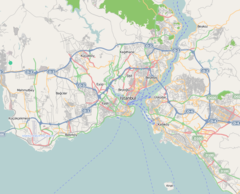







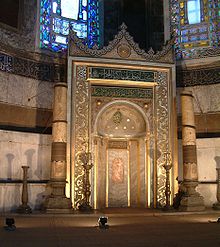
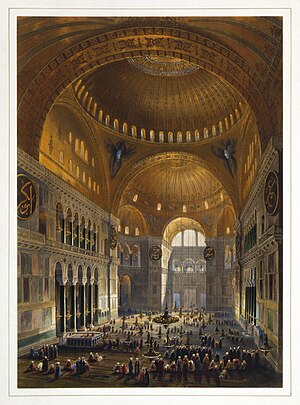


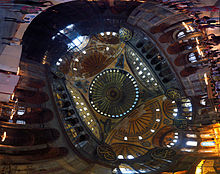

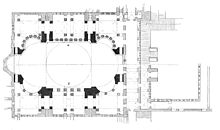





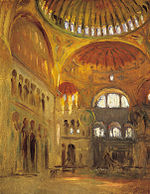

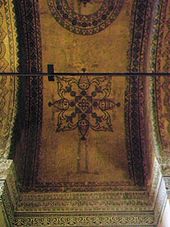






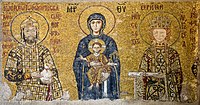





Tiada ulasan:
Catat Ulasan